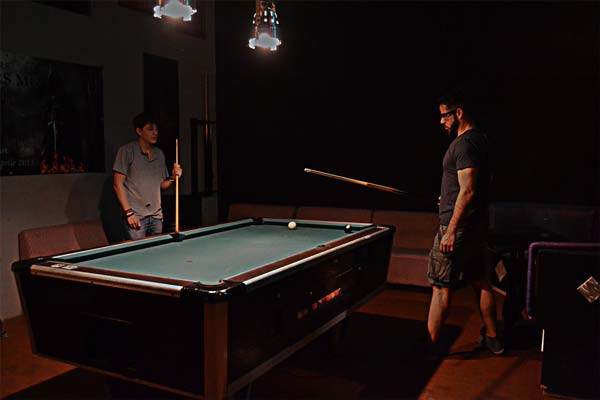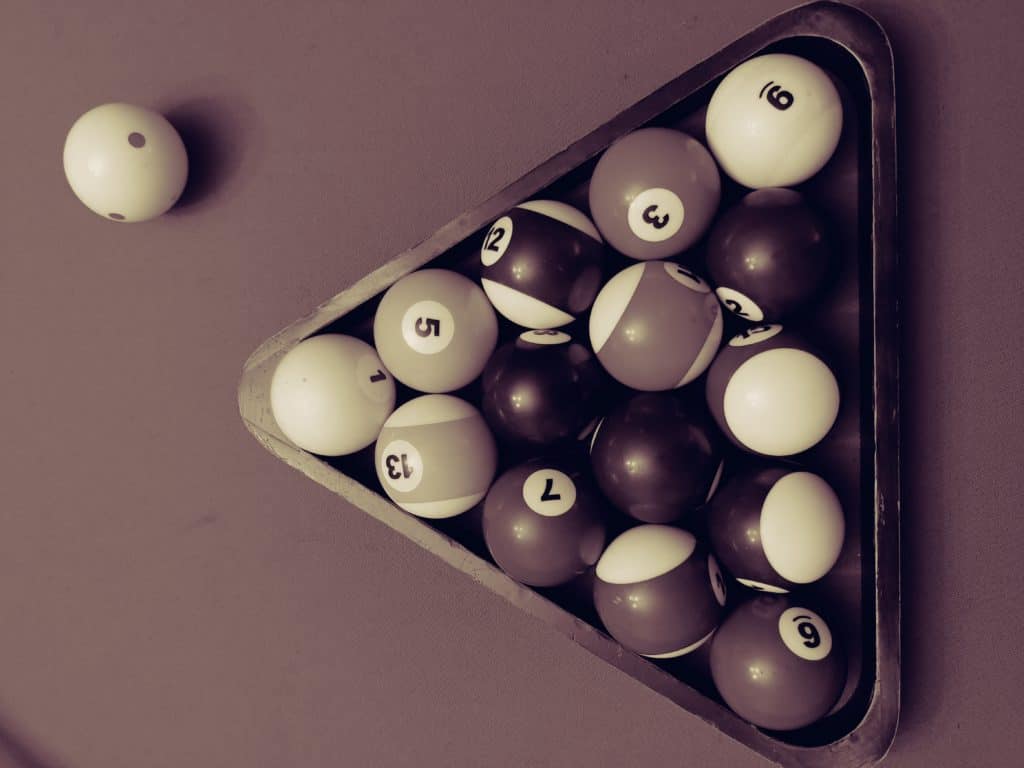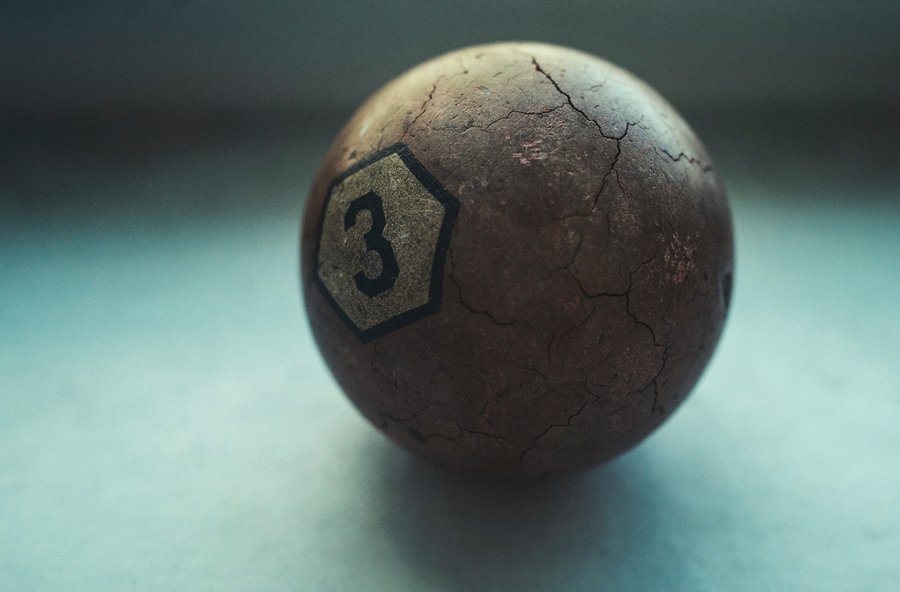You may have been enjoying a few games of pool at a local bar or pool hall and noticed that the cue ball was a different size than the others. There are several different ways this can happen. Differing sizes of pool balls, however, will usually not occur during league play.
Is the cue ball smaller? No, the cue ball is typically not smaller. If the cue ball is a different size than the object balls, it will be larger and not smaller.
This is usually the case when playing on a bar box or coin-op table. Using the same pool balls over time can also make them smaller and lighter. If the object balls are replaced and not the cue ball, it may be smaller than the others.
When damaged balls are replaced, it can also lead to differing sizes of pool balls on the table. Different brands may also construct their pool balls differently that can lead to size discrepancies.
To summarize the reasons:
- The cue ball can be larger when playing on a bar box or coin-operated table
- The owner may have replaced damaged or worn balls with newer ones
- The tables may have mixed sets, with pool balls from several sets
With so many ways of having different sized pool balls on the table, it’s important to understand how it happens as well as how it can affect your game.
Are there billiard games that mandate different sized pool balls? Why is the cue ball bigger when playing on a coin-op table? How can you tell if the pool balls are different sizes?
After learning more, talk to us in the comments about your experiences.
Reasons for Varying Pool Ball Sizes
We’ve listed the most common ways for different sized pool balls to find their way onto your pool table. Let’s look at each of these situations separately to truly understand how and why this can happen.

Coin-Operated Tables
Many coin-op pool tables, usually found in bars, have a series of mechanisms beneath the table that will separate the cue ball from the object balls that are pocketed. Any object balls that are pocketed will go into a holding chute until the next game is started with coins or tokens.
However, you will need to keep using the cue ball if you scratch so the table needs a way to give it back to you. If the cue ball is just a tad bit bigger, the table redirects it to an exit instead of holding onto it like it does the object balls.
Newer coin-op pool tables may use a magnetic cue ball instead of a larger ball. In this situation, the cue ball is usually the same as the object balls.
This means that any bar box or coin-operated table, the cue ball will be:
- Heavier and/or larger so the mechanisms can differentiate it
- Magnetic and the magnetic mechanisms below the table will differentiate it
Pool Ball Replacement

If a bar or pool hall sees a lot of billiard business, the pool balls can become worn, scratched, pitted, or even turn yellow. When this happens, many places will only replace the damaged pool balls instead of the entire set.
While this is certainly cheaper for the establishment, it can lead to the balls being used on a particular table being different sizes or weights. This can have an effect on your game, but so can the newer, smoother pool balls being used alongside those that have a rougher texture due to wear and tear.
What can happen when newer balls are replaced with worn out or damaged pool balls?
- A worn-out ball that is now smaller or lighter may travel faster when struck
- A ball with wear may not hit another one cleanly, which can send it in a different direction than intended
- A dirty or worn ball may travel differently than others on the surface of the pool table
- Newer balls that are heavier and smoother can travel in the intended direction but maybe not as far or farther depending on the other balls on the table
Have you noticed any unwanted effects when playing with a mixed set or a set with damaged or worn pool balls? Tell us about it!
Unintentional Mixed Sets
When there are many pool tables in use, whether at a bar or a pool hall, the sets being used at each may be different brands or different models from the same brand. It can be especially difficult to make sure that each table always gets pool balls from the same exact set. This means that most tables will be stocked with mixed sets and one point or another.
Sizes and Weights of Pool Balls
The pool ball of standard size and weight will have a diameter of 2 ¼” and a weight of approximately 6 ounces. As mentioned above, the cue ball may be a bit bigger on a coin-operated pool table. If it is, it will usually have a diameter of 2 3/8”. On rare occasions, you may find that all the balls in the rack are 2 3/8”. They will usually be slightly heavier as well.
You will usually only see pool balls in two sizes:
- 2 ¼”, 6 ounces (Standard size)
- 2 3/8”, slightly more than 6 ounces (Larger Coin op size)
Pool Ball Construction

Over the years, the materials used to make pool balls have changed drastically. The first ones were made of ivory. However, the game of pool was quickly becoming more popular in the early 1800’s while the cost of ivory was climbing. An inventor in New York invented the celluloid billiard ball.
They weren’t very durable, plus the players had to worry if the ball would explode if struck hard.
The first modern pool ball construction with a material called Bakelite. Bakelite was the most popular construction material and most pool balls were made that way by the 1920’s. With newer and more popular materials used today, they are made of resin, either plastic or acrylic.
These materials are very durable and make it much easier to construct pool balls of the same size and weight.
It’s important to note, however, that every brand will make their pool balls in a different way and with different materials.
This is the history of billiard ball construction material:
- Carved Wood (wear out quick, hard to make uniform)
- Ivory (held up with heavy use, expensive)
- Celluloid (made of volatile substances)
- Bakelike (very durable, lightweight, the standard for many decades)
- Resin (most modern, very durable)
More Info
While we may have answered the question of, “is the cue ball smaller?” it is still important to understand the different sizes of pool balls for most common play, the different appearances of them, as well as the size and weight of billiard balls used in different cue games.
Pool Balls for League Play
If you’re playing in a league, all pool balls will be of standard size and weight. This means 2 ¼” in diameter and a weight of 6 ounces. Depending on where the league play is happening, officials may weigh and measure the balls at each table to confirm they are standard. Other officials may only weigh and measure them if a discrepancy is noticed.
The Look of Pool Balls
When investing in your own set of billiard balls, there are many options to choose from. While most will have the standard cue ball, solids, stripes, and the 8-ball, some can be very creative. Some balls may have a different color than the standards.
Creative options for pool balls:
- Different graphics
- Different colors
- Sports team logos
- Person’s name
- Different numbers such as Roman numerals
Best Pool Ball Brands
Aramith has long been regarded as the best when it comes to billiard balls. In fact, more than 3 in every 4 pool players are using Aramith balls. However, there are also other brands that can give you the quality, appearance, and price point you are looking for. Other great choices in pool balls are Brunswick, Cyclop, and Iszy.
Want to see an in-depth list of the best budget and expensive billiard balls around? We wrote an article here where you can check it out!
Related Questions
We’ve covered a fair bit of information so far, but there are several questions that many pool players still have when it comes to the balls they use. Believe it or not, even those who have been playing for a while may have some of these same questions.
Are Snooker Balls Smaller?
The game of snooker may resemble billiards in many ways. The shape of the table is similar even those it is shorter and a bit bigger. There are pockets to send your object balls to, but those pockets are smaller. And the balls themselves are a bit smaller, plus there are more of them.
Modern sizing of snooker balls is 52.5mm. To be considered “standard” it needs to be within 0.05mm of that size. This means they are a tad over 2 1/16”, smaller than a traditional pool ball.
Does a Cue Ball Weigh More?
The cue ball in most sets will be the exact size and weight as the object balls. However, older coin-op pool tables may have one that is slightly bigger and heavier due to the mechanics of separating object balls from the cue ball under the table. It may be the same size but slightly heavier in coin-op tables that use magnets instead of mechanics.
Other than that, the cue ball should always be the same size as the others unless sets have been mixed or only certain balls have been replaced in a set.
What Are Ivory Billiard Balls and Why Don’t We Use Them Anymore?
The original game of pool utilized balls made of ivory when it quickly became apparent that carved wooden pool balls would never stand up to regular use. Ivory balls were very durable and made the game popular among the more elite of society. However, the game became more popular with other demographics and became a popular bar game. With the price and depleting resources for ivory, it became important to find alternatives.
The first “modern” pool balls were designed by John Wesley Hyatt in the late 1800’s. However, the material he used wasn’t very durable and was prone to exploding with enough force. By the 1920’s, most standard billiard balls were made of Bakelite, invented by Phelan Leo Baekeland. Today, more modern materials are used, like plastic or acrylic resin.
Why Do Some Cue Balls Have a Magnet inside?
While actually playing your game of pool, you may not even realize that the cue ball has a magnet inside it. Most sets don’t feature a cue ball with a magnet. So if it doesn’t affect the game and it’s not always necessary, why do some cue balls have an internal magnet?
Modern coin-operated billiards tables usually use a magnet under the table to separate it from the object balls that are then held inside the table until the next game is paid for. The magnet sends the cue ball in a different direction so you can use it again. Previous to this design, this was achieved by the mechanics of having a lightly larger cue ball. Many older coin-op tables still use this method.

